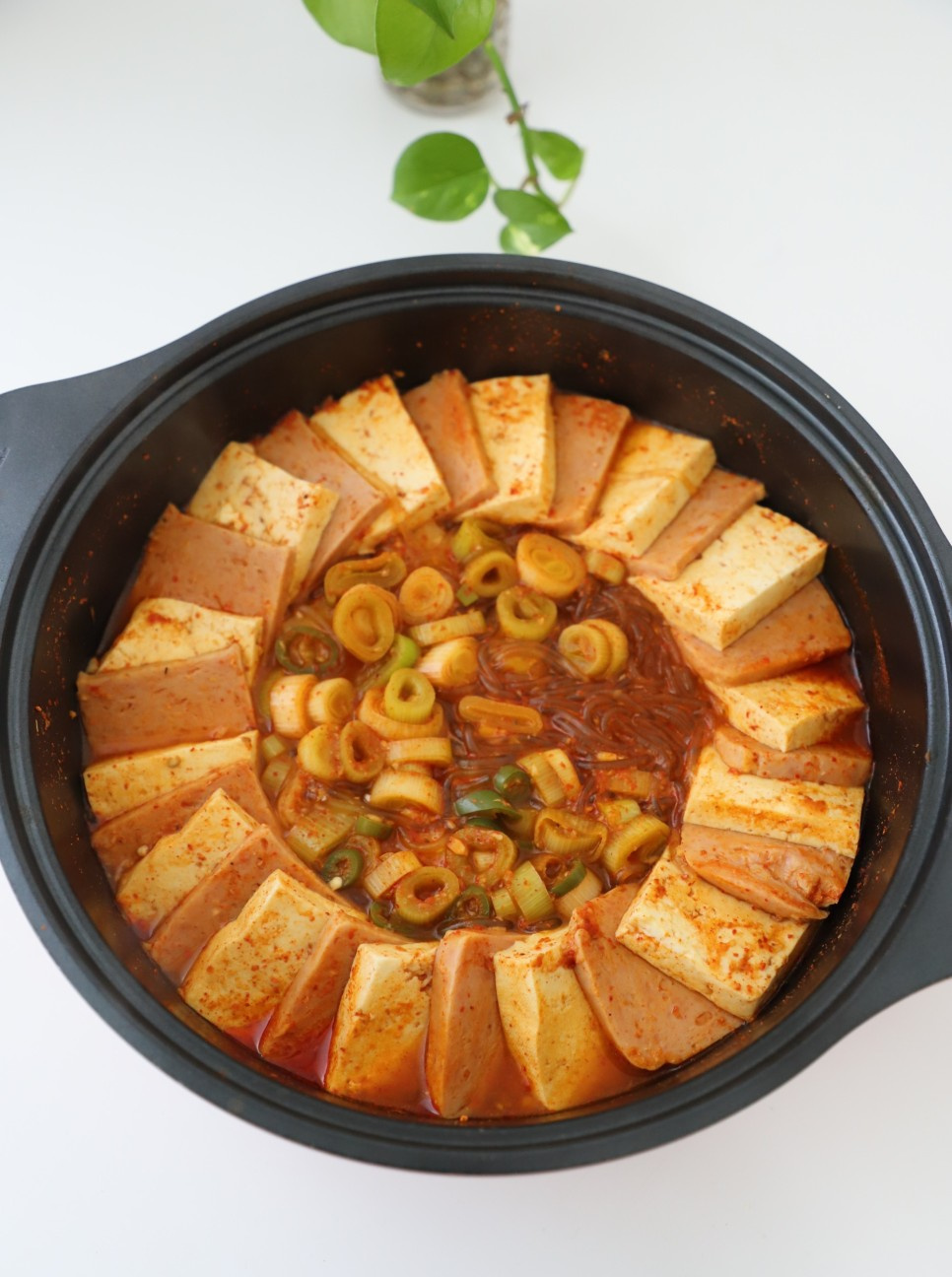Spam and Soft Tofu Stew (Jjigae)
The Ultimate Spam and Tofu Jjigae Recipe: A Rice-Stealing Dish Perfect for Dinner or as a Snack

While you can certainly make a delicious tofu dish without spam, adding it significantly boosts the savory flavor. This recipe is perfect for a satisfying dinner or a delightful drinking snack. It turns out beautifully presented and incredibly tasty, making it a dish you’ll be proud to have made yourself.
Stew Ingredients- 1 block soft tofu
- 1 can Spam (340g)
- 1 handful glass noodles
- 1 fistful of radish (about 1/8 of a medium radish)
- 1 stalk green onion
- 2 Korean chili peppers (cheongyang)
- 1 potato (optional)
- 1 onion (optional)
Seasoning Mix- 2 Tbsp gochugaru (Korean chili flakes)
- 1 Tbsp sugar
- 4 Tbsp soy sauce
- 1 Tbsp gochujang (Korean chili paste)
- 1/2 Tbsp doenjang (Korean soybean paste)
- 1 Tbsp minced garlic
- 2 Tbsp gochugaru (Korean chili flakes)
- 1 Tbsp sugar
- 4 Tbsp soy sauce
- 1 Tbsp gochujang (Korean chili paste)
- 1/2 Tbsp doenjang (Korean soybean paste)
- 1 Tbsp minced garlic
Cooking Instructions
Step 1
Prepare the radish, which adds a refreshing depth to the stew. Slice it into approximately 1 cm thick pieces. You’ll need about a fistful, roughly the size of one small onion.

Step 2
Slice the green onion diagonally or into bite-sized pieces.

Step 3
Finely chop the Korean chili peppers for a spicy kick.

Step 4
Cut the Spam and soft tofu into desired pieces. If you want to present the stew beautifully, try to cut both the Spam and tofu to similar sizes and layer them artfully. If you plan to mix and mash everything together while eating, you can cut them into more convenient, irregular shapes.

Step 5
Since Spam is quite salty, cutting it to about half the thickness of the tofu will ensure a more balanced and delicious flavor when you eat it.

Step 6
Soak a handful of glass noodles in lukewarm water for about 10-20 minutes. This helps them cook faster and prevents them from becoming mushy in the stew.

Step 7
Let’s make the sauce, the heart of this dish. In a bowl, combine 2 Tbsp gochugaru, 1 Tbsp sugar, 4 Tbsp soy sauce, 1 Tbsp gochujang, 1/2 Tbsp doenjang, and 1 Tbsp minced garlic.

Step 8
Mix all the seasoning ingredients thoroughly with a spoon until a smooth sauce is formed. You can adjust the amount of soy sauce to your taste, but 4 Tbsp provided a perfect balance for us.

Step 9
Start by placing the sliced radish (or potato and onion, if using) at the bottom of the pot. This step not only adds a refreshing taste to the broth but also helps prevent the ingredients from sticking or burning.

Step 10
Nicely arrange the Spam and tofu over the radish, layering them in an alternating pattern. A visually appealing arrangement will make the stew even more inviting.

Step 11
Add the pre-soaked glass noodles evenly over the Spam and tofu. The noodles will nestle among the other ingredients, absorbing the broth as they cook and adding a wonderful texture.

Step 12
Finally, sprinkle the chopped green onions and chili peppers over the top for a burst of color and freshness.

Step 13
Pour in enough water to roughly cover half of the ingredients. Then, pour the prepared seasoning sauce over the ingredients, distributing it evenly. You don’t need to submerge all the ingredients completely. (If you’re adding glass noodles, it’s a good idea to add a little extra water, as the noodles will absorb a significant amount of broth.)

Step 14
Bring the stew to a simmer over medium heat, gently stirring to help the sauce dissolve and meld with the broth. Avoid adding too much water initially, as this will require longer simmering time and can lead to the ingredients breaking apart. The beauty of ‘jjajjeong’ is in its concentrated flavor, so aim for a thicker consistency. Adjust the heat as it simmers to achieve the desired richness.

Step 15
If you’re wondering what to make with Spam or tofu, we highly recommend this easy-to-make Spam and Soft Tofu Jjajjeong for your next dinner! Your family will surely devour a whole bowl of rice with it. Enjoy your delicious meal!



